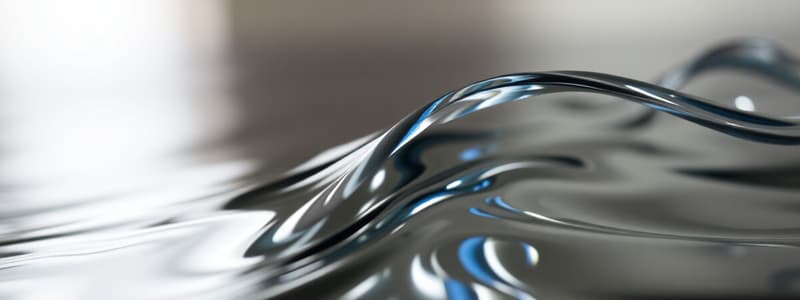Podcast
Questions and Answers
Which type of wave interaction causes a wave to bounce back after hitting a surface?
Which type of wave interaction causes a wave to bounce back after hitting a surface?
- Diffraction
- Absorption
- Reflection (correct)
- Refraction
What results when a wave passes from one medium to another and changes speed?
What results when a wave passes from one medium to another and changes speed?
- Refraction (correct)
- Diffraction
- Reflection
- Interference
What is the result of light being dispersed into different colors?
What is the result of light being dispersed into different colors?
- Interference
- Diffraction
- Dispersion (correct)
- Absorption
What occurs when a wave bends around an object or through a narrow slit?
What occurs when a wave bends around an object or through a narrow slit?
Why does a blue car appear blue?
Why does a blue car appear blue?
What phenomenon causes the sky to appear blue during the day?
What phenomenon causes the sky to appear blue during the day?
What type of reflection occurs when light is scattered in many directions?
What type of reflection occurs when light is scattered in many directions?
What is the outcome of absorption of a wave by a substance?
What is the outcome of absorption of a wave by a substance?
What determines the direction of reflection when a wave hits a surface?
What determines the direction of reflection when a wave hits a surface?
What primarily causes a wave to bend when it enters a different medium?
What primarily causes a wave to bend when it enters a different medium?
Which phenomenon describes the spreading of light into a spectrum of colors?
Which phenomenon describes the spreading of light into a spectrum of colors?
Which factor does NOT affect the appearance of the sky's color?
Which factor does NOT affect the appearance of the sky's color?
What happens to the intensity of a wave after absorption by a substance?
What happens to the intensity of a wave after absorption by a substance?
In diffuse reflection, how does a wave behave upon hitting an irregular surface?
In diffuse reflection, how does a wave behave upon hitting an irregular surface?
Why does a blue car appear blue rather than another color?
Why does a blue car appear blue rather than another color?
Which of the following best describes interference in wave interactions?
Which of the following best describes interference in wave interactions?
Flashcards
Wave Reflection
Wave Reflection
Wave bouncing back from a surface it can't penetrate.
Angle of Reflection
Angle of Reflection
Angle of the incoming ray equals angle of the outgoing ray.
Diffuse Reflection
Diffuse Reflection
Waves reflect in many directions from an uneven surface.
Wave Refraction
Wave Refraction
Signup and view all the flashcards
Wave Diffraction
Wave Diffraction
Signup and view all the flashcards
Wave Absorption
Wave Absorption
Signup and view all the flashcards
Light Dispersion
Light Dispersion
Signup and view all the flashcards
Color Perception
Color Perception
Signup and view all the flashcards
Rainbow Formation
Rainbow Formation
Signup and view all the flashcards
Why is the Sky Blue?
Why is the Sky Blue?
Signup and view all the flashcards
Types of Wave Interactions
Types of Wave Interactions
Signup and view all the flashcards
Reflection
Reflection
Signup and view all the flashcards
Diffuse Reflection
Diffuse Reflection
Signup and view all the flashcards
Refraction
Refraction
Signup and view all the flashcards
Diffraction
Diffraction
Signup and view all the flashcards
Absorption
Absorption
Signup and view all the flashcards
Study Notes
Types of Wave Interactions
- Key interactions include reflection, refraction, diffraction, absorption, and interference.
Reflection
- Occurs when a wave encounters a surface it cannot penetrate, resulting in the wave bouncing back.
- The incident angle (incoming ray) is equal to the reflected angle.
Diffuse Reflection
- Happens when waves reflect in multiple directions due to irregular surfaces.
Refraction
- Refers to the bending of a wave as it moves between different media, influenced by varying wave speed.
- The speed change alters the angle of the wave, causing it to bend.
Diffraction
- The process of wave bending as it passes around obstacles or through narrow openings, leading to spreading out.
Absorption
- Energy of a wave is taken up by a substance, preventing it from passing through or reflecting.
- Transmitted waves retain less intensity compared to the original waves.
Light Dispersion
- The separation of light into its constituent colors based on frequency.
Color Perception
- An object's color is determined by the wavelengths of light it reflects; for instance, a blue car reflects blue wavelengths and absorbs others.
Rainbows
- Formed from the dispersion of sunlight through tiny water droplets, leading to a spectrum of colors.
Blue Sky Explanation
- The sky appears blue due to selective scattering of light by atmospheric nitrogen and oxygen molecules.
- Violet light scatters the most, followed by blue, green, yellow, orange, and red, with human eyes being more sensitive to blue light.
Types of Wave Interactions
- Key interactions include reflection, refraction, diffraction, absorption, and interference.
Reflection
- Occurs when a wave encounters a surface it cannot penetrate, resulting in the wave bouncing back.
- The incident angle (incoming ray) is equal to the reflected angle.
Diffuse Reflection
- Happens when waves reflect in multiple directions due to irregular surfaces.
Refraction
- Refers to the bending of a wave as it moves between different media, influenced by varying wave speed.
- The speed change alters the angle of the wave, causing it to bend.
Diffraction
- The process of wave bending as it passes around obstacles or through narrow openings, leading to spreading out.
Absorption
- Energy of a wave is taken up by a substance, preventing it from passing through or reflecting.
- Transmitted waves retain less intensity compared to the original waves.
Light Dispersion
- The separation of light into its constituent colors based on frequency.
Color Perception
- An object's color is determined by the wavelengths of light it reflects; for instance, a blue car reflects blue wavelengths and absorbs others.
Rainbows
- Formed from the dispersion of sunlight through tiny water droplets, leading to a spectrum of colors.
Blue Sky Explanation
- The sky appears blue due to selective scattering of light by atmospheric nitrogen and oxygen molecules.
- Violet light scatters the most, followed by blue, green, yellow, orange, and red, with human eyes being more sensitive to blue light.
Studying That Suits You
Use AI to generate personalized quizzes and flashcards to suit your learning preferences.




